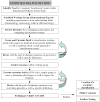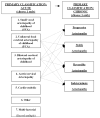Towards a consensus-based classification of childhood arterial ischemic stroke
- PMID: 22156694
- PMCID: PMC3312781
- DOI: 10.1161/STROKEAHA.111.624585
Towards a consensus-based classification of childhood arterial ischemic stroke
Abstract
Background and purpose: The implementation of uniform nomenclature and classification in adult arterial ischemic stroke (AIS) has been critical for defining outcomes and recurrence risks according to etiology and in developing risk-stratified treatments. In contrast, current classification and nomenclature in childhood AIS are often overlapping or contradictory. Our purpose was to develop a comprehensive consensus-based classification system for childhood AIS.
Methods: Using a modified-Delphi method, members of the International Pediatric Stroke Study (IPSS) developed the Childhood AIS Standardized Classification And Diagnostic Evaluation (CASCADE) criteria. Two groups of pediatric stroke specialists from the IPSS classified 7 test cases using 2 methods each: (1) classification typical of the individual clinician's current clinical practice; and (2) classification based on the CASCADE criteria. Group 1 underwent in-person training in the utilization of the CASCADE criteria. Group 2 classified the same cases via an online survey, including definitions but without training. Inter-rater reliability (IRR) was assessed via multi-rater unweighted κ-statistic.
Results: In Group 1 (with training), IRR was improved using CASCADE criteria (κ=0.78, 95% CI=[0.49, 0.94]), compared with typical clinical practice (κ=0.40, 95% CI=[0.11, 0.60]). In Group 2 (without training), IRR was lower than among trained raters (κ=0.61, 95% CI=[0.29, 0.77]), but higher than current practice (κ=0.23, 95% CI=[0.03, 0.36]).
Conclusions: A new, consensus-based classification system for childhood AIS, the CASCADE criteria, can be used to classify cases with good IRR. These preliminary findings suggest that the CASCADE criteria may be particularity useful in the setting of prospective multicenter studies in childhood-onset AIS, where standardized training of investigators is feasible.
Figures
References
-
- Kang DW, Chalela JA, Ezzeddine MA, Warach S. Association of ischemic lesion patterns on early diffusion-weighted imaging with TOAST stroke subtypes. Arch Neurol. 2003;60:1730–1734. - PubMed
-
- Kolominsky-Rabas PL, Weber M, Gefeller O, Neundoerfer B, Heuschmann PU. Epidemiology of ischemic stroke subtypes according to TOAST criteria: incidence, recurrence, and long-term survival in ischemic stroke subtypes: a population-based study. Stroke. 2001;32:2735–2740. - PubMed
-
- Markus HS, Khan U, Birns J, Evans A, Kalra L, Rudd AG, et al. Differences in stroke subtypes between black and white patients with stroke: the South London Ethnicity and Stroke Study. Circulation. 2007;116:2157–2164. - PubMed
-
- Diener HC, Sacco R, Yusuf S. Rationale, design and baseline data of a randomized, double-blind, controlled trial comparing two antithrombotic regimens (a fixed-dose combination of extended-release dipyridamole plus ASA with clopidogrel) and telmisartan versus placebo in patients with strokes: the Prevention Regimen for Effectively Avoiding Second Strokes Trial (PRoFESS) Cerebrovasc Dis. 2007;23:368–380. - PubMed



